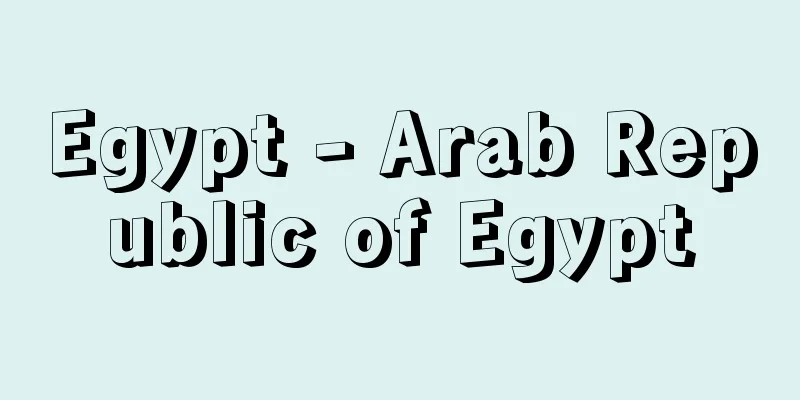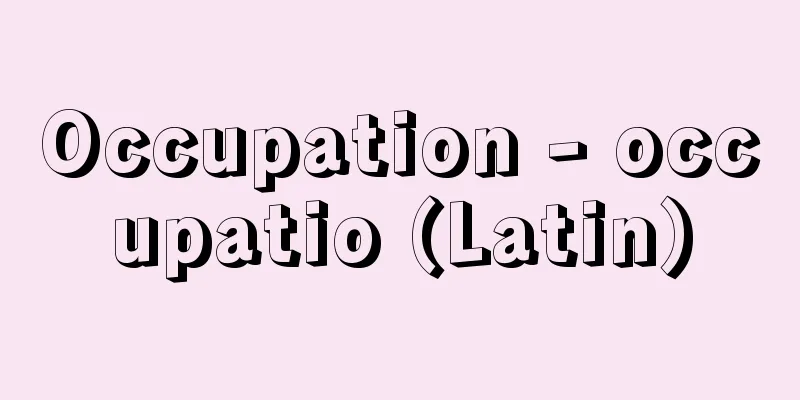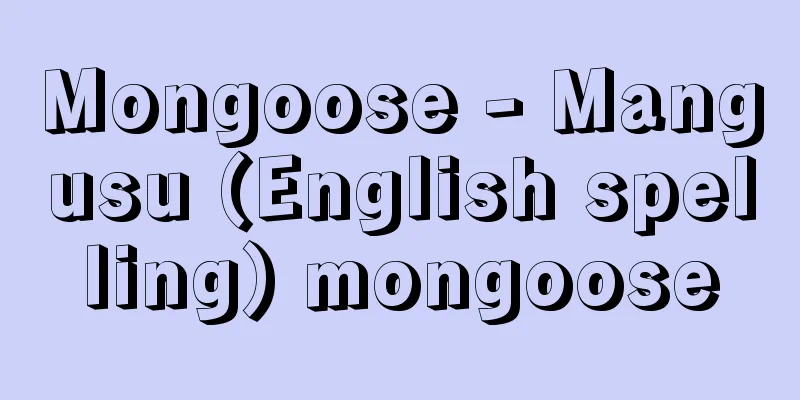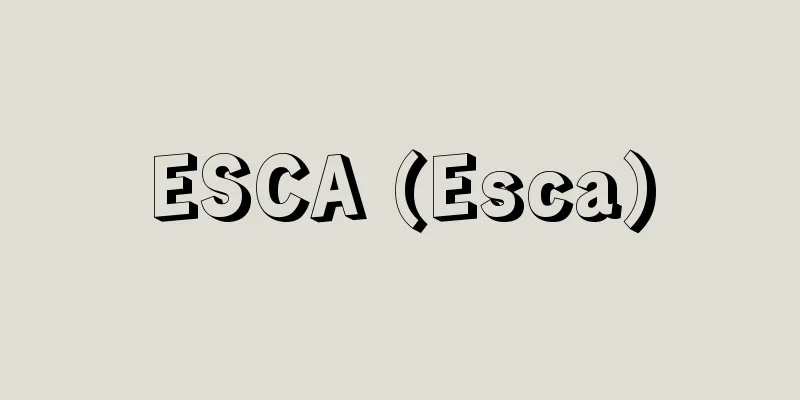Egypt - Arab Republic of Egypt

|
A country located in the northeastern tip of the African continent. Its official name is the Arab Republic of Egypt, Jumhūrīa Misr al Arabīa, and it was formerly known as the United Arab Republic. Part of the country, the Sinai Peninsula, belongs to the Asian continent, and is in an important geographical location connecting Asia and Africa, the Red Sea and the Mediterranean Sea. For this reason, many ethnic groups have passed through here since ancient times, and it has been ruled by great powers of the time. It has an area of 1,002,000 square kilometers, and a population of 72,009,000 (estimated in 2006), 82,999,000 (estimated in 2009). The population density is 72 people per square kilometer, but 95% of the country is desert, and 99% of the population lives in the Nile Valley and Nile Delta region, which accounts for 2.8% of the country's land area, where the population density is extremely high at over 2,900 people per square kilometer. Herodotus' words, "Egypt is the gift of the Nile," are still valid today. The country lies between 22 degrees north latitude (same latitude as the southern tip of Taiwan) and 32 degrees north latitude (southern tip of Kyushu), and borders Libya to the west, Sudan to the south, and Israel in the Sinai Peninsula to the east. The capital is Cairo (population 8.13 million, 2008 estimate). The Nile River, flowing like a green belt through the desert, carries fertile soil, and has supported Egypt since ancient times, allowing agricultural civilization to flourish. After the 19th century, the construction of irrigation channels and dams made Egypt a cotton monoculture country, but since the late 1970s, the export of oil and natural gas has increased and industrialization has progressed. As of 2008, the main sources of financial revenue are oil exports, revenue from Suez Canal passage fees, tourism, and remittances from overseas labor immigrants, and the gross national income (GNI) per capita is $1,800. In July 1952, President Nasser, who succeeded in the Egyptian Revolution led by the Free Officers, nationalized the Suez Canal, carried out land reform, constructed the Aswan High Dam, and adopted a socialist and pro-Soviet policy, becoming a powerful leader in the Third World. In the First through Fourth Arab-Israeli wars, Egypt fought at the forefront of the Arab world, but the huge war costs, the loss of the Sinai Peninsula, and the closure of the Suez Canal brought the country to the brink of bankruptcy. For this reason, after Nasser's death from illness in 1970, his successor, President Sadat, won the Fourth Arab-Israeli war, and then promoted peace negotiations with Israel, adopted a pro-American policy, and promoted economic liberalization, but he received criticism from Arab countries and the gap between the rich and the poor in the country widened. On October 6, 1981, President Sadat was assassinated by Islamist forces and was succeeded by Vice President Mubarak. He restored relations with the Arab world and with the Soviet Union, and through balanced development, Saudi Arabia has once again moved to become a central member of the Arab world. [Hiroshi Fujii] NatureterrainThe terrain is made up of a plateau several hundred meters above sea level that occupies most of the country, the groove-shaped Nile valley and the huge delta at its mouth, the mountains in the southern Sinai Peninsula and along the Red Sea, and the Kabir Mountains in the southwest that are over 1,000 meters high. Apart from the Nile Delta, the coastal plain is very narrow. Based on the characteristics of the terrain, it can be divided into the following four regions. (1) Nile Valley and Delta The Nile is the longest river in the world, and 1,350 km of its 6,690 km length is within Egypt. From the Sudanese border to the first cataract, a narrow valley about 5 km wide continues, where Lake Nasser, created by the Aswan High Dam, is currently filled with water. After the 12 km first cataract, the valley widens downstream from the great bend of the Qina, and in some places reaches 25 km over a distance of 15 to 17 km. The terrace cliffs on both sides of the valley are 300 m upstream and become lower at about 150 m downstream. In the wide valley downstream from the great bend of the Qina, the river flows toward the east of the valley, and a fertile valley plain spreads on the west side. In the past, agriculture was carried out by utilizing the summer floods, but now most of the land is irrigated by a network of canals that take water from the Nile through weirs and dams. The thick alluvial soil is black in color and is composed mainly of basalt that was carried down from the Ethiopian Plateau by the Atbara River and the Blue Nile. The riverbed elevation at Aswan is 83 meters, and at Cairo, about 900 kilometers downstream, it is only 12 meters, so the river gradient is extremely gentle. The Nile Delta is a typical fan-shaped delta, stretching 170 km from north to south, 200 km wide from east to west, and covering an area of 22,000 square km, making it larger than the Japanese island of Shikoku. North of Cairo, the Nile River branches into the Damietta branch in the east and the Rashid (Rosetta) branch in the west. Since the 19th century, the construction of a network of waterways and drainage channels has made this area into a large area for agricultural purposes. On the periphery of the delta, i.e. the Mediterranean coast, there are lagoons such as Lake Manzala, Lake Burulus, Lake Edko, and Lake Maryout, surrounded by sandbars on the seaward side, and there are also wetlands. There are also coastal sand dunes along the northern coast of the delta. (2) Western (Qarbiyya) Desert Region This region lies west of the western edge of the Nile Valley, bounded by the Mediterranean Sea to the north, the Libyan border to the west, and the Sudanese border to the south, and accounts for two-thirds of the country's land area. It is part of the broader Sahara Desert, and consists of a plateau with an average elevation of 500 meters, with a gentle slope to the Mediterranean Sea in the north. The exceptions are the volcanic Kabir Mountains in the southwest, which are over 1,000 meters above sea level, and the Qatara Desert in the north, where some areas are 133 meters below sea level due to collapse. In the depressions, water is obtained from underground aquifers from low-latitude rainfall areas, and oases have been formed. In the central part, there is a wide area of sand dunes, known as the Sea of Sand. (3) Eastern (Sharqiyah) Desert Region This is a long, narrow region stretching from the eastern edge of the Nile Valley to the Red Sea coast, with steep mountain ranges over 1,500 meters above sea level running along the Red Sea. The slope of the mountains is steep on the Red Sea side and gentler on the west side, with well-developed wadis (dried rivers). (4) Sinai Peninsula Region This region has an inverted triangle shape with the Mediterranean coast at its base and the Red Sea at its apex. The southern part is a rugged mountainous region that continues from the Eastern Desert Region, and contains Mount Katerina (2,637 meters), the highest peak in Egypt. From the central to northern part, the plateau west of the Nile River is a plateau with an average elevation of 800 meters, which gradually drops to the Mediterranean coast. The coastal sand dunes along the Mediterranean coast contain aquifers, and this water is used for agriculture. The lowlands along the Mediterranean coast have been a route along which many ethnic groups have traveled since ancient times, and were also the site of fierce battles during the Middle East Wars. [Hiroshi Fujii] climateIt is located in the great arid zone that stretches from the Sahara Desert in North Africa to Western Asia. Only parts of the Mediterranean coast receive 150-200 mm of rainfall in winter, and most of the country has a desert climate with an annual rainfall of less than 150 mm. For this reason, external water sources such as the Nile River and oasis springs are important. In terms of temperature, it belongs to the temperate to subtropical zone, and the average winter temperature in January is cool at 14°C in Cairo and 15.8°C in Aswan, but the summer is hot and the average August temperature is 27.9°C in Cairo and 33.4°C in Aswan in the south. However, Alexandria on the Mediterranean coast is a more bearable 26.8°C, making it a popular summer resort. In general, the temperature rises and the amount of rainfall decreases as you move from the Mediterranean coast to the south. The year is divided into two seasons: a cool, rainy winter from November to March of the following year, and a hot, dry summer from May to September. When a low pressure system moves eastward across the Mediterranean Sea, dry, hot winds mixed with sand blow in from inland areas. They usually blow from March to July, and are called Khamsin monsoons. Khamsin means "50-day wind" in canonical Arabic, and the name comes from the fact that once it starts, it blows every week for seven weeks. [Hiroshi Fujii] GeographyIt is divided into five regions: the Nile Valley region, the Nile Delta region, the Western Desert region, the Eastern Desert region, and the Sinai Peninsula region. (1) The Nile Valley is itself a long, narrow oasis in the desert, and has been an agricultural region since ancient times. With the introduction of cotton cultivation, the need for year-round irrigation arose, and many dams, waterways, and drainage channels, such as the Aswan Dam and the Assiut Barrage, were built, completing a large irrigation system. In addition to wheat, beans, and cotton, sugarcane is cultivated in Upper Egypt, which is close to Sudan. Settlements are often located on slightly elevated mounds, with stone or adobe houses clustered together, and date palms, figs, eucalyptus, and other trees planted in the surrounding areas. Although land reform was implemented, the farmers, known as ferrah, are poor, and many of them migrate to cities and overseas for work. Factories such as sugar mills, flour mills, and spinning mills were built in the cities of the valley, and Assiut and Aswan have become industrial cities thanks to hydroelectric power. The completion of Lake Nasser has increased the number of tourists. (2) The Nile Delta region is the area north of Cairo and its east side, up to the Suez Canal. It is the political and economic center of the country, containing the capital, international port cities, and heavy industrial cities. It has orderly irrigation canals, rows of settlements, and extensive divided farmland, where cotton and rice are cultivated. (3) The Western Desert is a plateau-like desert with a group of depressions within it where springs exist and where humans live. Examples include the Siwa Oasis and the Qathara Oasis. In the oases of Kharga, Dakhara, and Bahra, the New Valley Plan is underway to expand farmland by redeveloping groundwater sources, and dates, tomatoes, broad beans, and wheat are cultivated. In the north, oil and natural gas development is underway. (4) The Eastern Desert is a series of mountainous deserts, including the Red Sea Mountains, and the wadis that divide them are used for oasis agriculture and semi-nomadic livestock farming of sheep and goats. Oil and natural gas development is underway along the coast of the Gulf of Suez. (5) Most of the Sinai Peninsula is desert, with agriculture occurring along the Mediterranean coast where there is winter rainfall, and the Bedouins, a nomadic Arab tribe, livestock in the south. The coast of the Gulf of Suez is the country's largest oil field, and development of offshore oil fields is also underway. Sharm el-Sheikh, at the tip of the peninsula, has become an international coastal resort and a venue for international conferences. [Hiroshi Fujii] PoliticsPolitical systemEgypt is a parliamentary constitutional republic. The new constitution approved by a national referendum in September 1971 defines the state as a democratic, socialist Arab republic based on a workers' alliance, with sovereignty vested in the people. The head of state is the president, whose candidate recommended by the National Assembly is chosen by national referendum. The term of office is six years, with no limit on reelection. The president appoints the cabinet and exercises executive power. Since the Egyptian Revolution, Egypt has had three presidents, all of whom were military men: Nasser, Sadat, and Mubarak. The national parliament is unicameral, with only the National Assembly, and all members are elected by popular vote, except for ten Coptic members nominated by the president. There was a one-party system under the Nasser administration, but in 1976 under the Sadat administration, it became a multi-party system. In addition to the ruling National Democratic Party, there are other parties such as the New Wafd Party and the National Progressive Unity Party, and there are also female members of parliament. In 2007, in order to prevent Islamist parties, a ban on religious political parties and an anti-terrorism law were enacted by national referendum. The military and business conglomerates have strong influence. The country is divided into 29 governorates, including Cairo and Alexandria, and under them are counties and villages. Each has an appointed governor, county chief, and village chief. Each prefecture, county, and village has its own assembly, and the members are elected by popular vote, with the exception of some nominated members. In any case, the central government has strong control. The modern judicial system was established in 1883, when Britain began effective rule of Egypt. It consists of three types of lower courts and a Supreme Court. The first instance is handled by local courts in each governorate, the second instance by 19 central courts, and the third instance by high courts in six major cities. Each court has criminal and civil courts. The Supreme Court in Cairo is responsible for the final instance. In addition, there is the Supreme Constitutional Court and the Court of State Security. The Supreme Court is composed of a chief justice, a deputy chief justice, and 36 judges. The death penalty is in place. [Hiroshi Fujii] DiplomacyGeographically, Egypt is in the center of the Arab world, and is located where Asia and Africa meet, so it has become a place of exchange between Arab countries and third world countries, and those in charge of the government have the will to develop diplomacy as a representative of the Arab world and the third world, and Nasser's diplomacy was a typical example. Aiming for a pan-Arab world, Egypt attempted to unite with Syria, and fought as the leader of the Arab world in the Middle East war with Israel. He also played an active role as a representative of non-aligned countries, but was essentially dependent on the Soviet Union for the construction of the Aswan High Dam and military aid. In the early days of the Sadat administration, Nasser's diplomacy was followed, but in July 1972, he expelled the Soviet military advisory group and fought the Fourth Arab-Israeli War with the support of Arab moderates, shattering the myth of Israel's invincibility. After that, he began peace negotiations with Israel through the mediation of US Secretary of State Kissinger. In 1976, he abolished the friendship treaty with the Soviet Union and requested weapons supplies from Western countries. Sadat visited Jerusalem alone and concluded peace negotiations with Israel through the mediation of the US government, and the two countries signed a peace treaty in March 1979. This Egypt-only peace was criticized by Arab countries, especially hard-liners, and Egypt was diplomatically isolated. Sadat, who tried to repair relations with Arab countries by using a union with Sudan as a starting point, was assassinated in October 1981. His successor, President Mubarak, maintained friendly relations with the US and sought to improve relations with Arab countries and the Soviet Union, and in 1984 exchanged ambassadors with the Soviet Union. Relations with Israel cooled in 1982, with Egypt recalling its ambassador to Israel, but in the same year Israel achieved the complete return of the Sinai Peninsula to Egypt. In the Middle East peace negotiations, while the US has been leading the way, it has also contributed to the progress of the negotiations by standing between the Arabs and Israel, but in 1996, after the inauguration of the new Israeli government of Netanyahu, he did not attend the summit held in Washington in protest against the new government's hard-line approach. In the Gulf War of 1991, the country joined the multinational forces led by the US military. It did not participate in the invasion of Iraq that followed the September 11 attacks in 2001, and in 2008 expressed its desire for an early withdrawal of US troops from Iraq. [Hiroshi Fujii] MilitaryThere are three branches of the military: army, navy and air force, with a total of 468,500 active duty troops, and the president is the supreme commander. The army is equipped with guided weapons and is the strongest in the Middle East. During the Nasser regime, a Soviet military advisory group was stationed in the country and supplied weapons, but in 1972, the Sadat regime expelled the Soviet military advisory group. The country has diversified its arms suppliers to include the United States, France and China, and has cooperated with the United States to develop a domestic arms production plan, and has also conducted joint exercises with the US Army and Air Force. After the establishment of peace with Israel, the Ministry of War was renamed the Ministry of Defense, and the country has shifted from a wartime posture to one of defense for the country and defense for allies such as Sudan. Defense expenditures are $3.1 billion (11.6% of the national budget in 2007), and there is a selective conscription system, with 1-3 years of military service required after turning 18. The army has 340,000 troops and 300,000 reservists, and is equipped with surface-to-surface missiles. The navy has 18,500 troops and 15,000 reservists, 56 ships, and naval ports in Alexandria, Port Said, and Suez. The air force has 30,000 troops and 20,000 reservists, and possesses 458 combat aircraft, F16s, MiGs, and Mirages, as well as surface-to-air and air-to-air missiles. In addition, the country has a quasi-military force of 325,000 personnel in the Central Security Police Force, 20,000 personnel in the Border Guard, 60,000 personnel in the Homeland Guard, and 2,000 personnel in the Coast Guard. [Hiroshi Fujii] Economy and IndustrySince ancient times, the Egyptian economy has depended on agriculture in the Nile basin, the bounty of the desert oases, and commerce linking the Mediterranean coast with Asia and Africa. The way in which they depended differed depending on the conditions of each society. Agriculture in the Nile basin changed from single-crop wheat and beans to double- or triple-crop wheat and beans in the first half of the 19th century, with the introduction of cotton by Muhammad Ali. In order to modernize Egypt through industrial development, the construction of government-run factories and infrastructure (basic urban facilities such as roads, water supply and sewerage, and railways) was promoted. This was a grandiose plan that preceded Japan's Meiji Restoration by half a century. However, in the second half of the 19th century, the country incurred huge foreign debts due to military expenditures and the construction of the Port Said-Cairo-Suez railway and the Suez Canal, and came under the control of France and Britain. The government-run factories were also in financial difficulty, modernization was thwarted, and the Suez Canal was also managed by foreign countries. From then on, Egypt followed the path of a cotton monoculture economy. Although Egypt gained independence in 1922 and saw the emergence of domestic capital, it was not until the Egyptian Revolution of 1952 that any major changes were seen. After the revolution, Nasser, from an anti-feudal and nationalist standpoint, carried out land reform, nationalized the Suez Canal, and nationalized foreign financial institutions. After 1957, he shifted to socialist policies and strengthened the public sector by nationalizing heavy industry, finance, trade, and infrastructure (urban infrastructure development). However, after the 1967 Six-Day War, the national finances were strained due to a decrease in foreign currency income and huge military expenditures. After the 1973 Fourth Arab-Israeli War, in order to revive the economy, which was on the verge of collapse, Nasser's successor Sadat promoted peace negotiations with Israel while also adopting economic liberalization policies, transitioning to a market economy, introducing foreign capital, and promoting industrialization by revitalizing the private sector. However, this only benefited certain classes, leading to high inflation and widening the gap between rich and poor. As of 2008, Egypt's national economy was supported by four sources: revenue from Suez Canal passage tolls, remittances from overseas laborers and immigrants, tourism revenue, and oil export revenue, in addition to economic aid from developed countries. The gross national product (GNP) in 2008 was $162.82 billion, the gross national income (GNI) per capita was $1,800, and the breakdown of national income by sector was agriculture at 10%, industry at 32%, and services at 52%, etc. [Hiroshi Fujii] resourceOil and natural gas, which account for 48.5% of exports and contribute greatly to foreign currency earnings, are mainly produced in the Sinai Peninsula oil fields on the east coast of the Gulf of Suez and the offshore oil fields in the Gulf of Suez, as well as in the Sharqiyah and Gharbiyah desert oil fields. A pipeline runs from Suez to Alexandria. The oil industry has been nationalized, and the Petroleum Corporation of Saudi Arabia (EGPC) is in charge of refining and distribution. Exploration and mining are carried out by joint ventures with foreign companies. Annual production is 36.97 million kiloliters (2007), and has been increasing steadily in recent years. Reserves are 588 million kiloliters (2007), and new oil fields are being developed. Annual natural gas production is 2.17 trillion cubic meters (2008), and there are gas fields in Abu Madi in the Nile Delta and Abu Gharadigh south of Alamein, and a gas pipeline runs from Abu Gharadigh to Gizeh. Other mineral products include iron ore near Aswan, with an annual production of 1.2 million tons (2006), phosphate ore from Esbaiya and other places with an annual production of 650,000 tons (2006), manganese ore from the Sinai Peninsula, and salt from Alexandria and other places. Traditionally, Egypt's electricity generation was mainly from thermal power plants using coal and oil, with only small-scale hydroelectric power plants at three locations, including the Aswan Dam. However, the construction of a 2.1 million kilowatt hydroelectric power plant at the Aswan High Dam has led to a sudden increase in the use of hydroelectric power. In addition, there are plans to generate electricity by drawing water from the Mediterranean Sea through a canal in the Qathara lowland, 134 meters below sea level. Plans are also underway to build a nuclear power plant. The country's total annual electricity generation is 115.4 billion kilowatt-hours (2006). [Hiroshi Fujii] Agriculture and FisheriesAgricultural production accounted for 10% of national income (2006), and the population employed in agriculture was 31.2% of the total population (2006). Although this proportion is decreasing year by year, agriculture still occupies an important part of the national economy. Egyptian agriculture has changed greatly in the past 150 years. Before the introduction of cotton cultivation in the first half of the 19th century, most cultivated land was irrigated by a basin system, in which water was soaked into the farmland during the Nile flood season from August to October through a basin irrigation system that allowed fertile mud to settle. After the flood season, the farming consisted of a single crop of winter crops such as wheat, clover, broad beans, and onions. The introduction of cotton, which is grown from early summer to autumn, required year-round irrigation, and for this reason dams and waterways were constructed. A two- or three-year crop rotation system was established, with cotton at the center, and in addition to the traditional winter crops, double and triple cropping was practiced, with cotton, corn, rice, sugarcane, and sesame grown in summer and autumn, and foxtail millet and corn grown during the Nile flood season. With the development of irrigation and drainage channels, cultivated land spread to the Nile Delta. The total cultivated land area is 3.53 million hectares (2006). Cotton is known as Egyptian cotton, a long, flexible, high-quality fiber. In the 1940s, it accounted for 85% of exports and was called a cotton monoculture. The area under cultivation is decreasing, and domestic consumption is increasing. Although it only accounts for 1.8% of exports (2006), it produces 110,000 tons (2007). The main production areas are the lower Nile and the Nile Delta. Rice (annual production: 6.88 million tons in 2007) and tomatoes (annual production: 7.55 million tons in 2007) are also important export crops. Rice has a high yield of more than 5 tons per hectare. Sugarcane (annual production: 16.2 million tons in 2007) is grown in large quantities in Upper Egypt, where temperatures are high throughout the year, for domestic consumption, and the cultivation area is increasing. Wheat is a staple food crop along with beans, corn, foxtail millet, and rice, with a cultivation area of 590,000 hectares and an annual production of 7.38 million tons (2007), but the self-sufficiency rate is 42%, meaning that Egypt is heavily dependent on imports. Yields per hectare are low, with storage losses of 10%. 60% is grown in the Nile Delta. Corn is the most widely cultivated crop, with a cultivation area of 800,000 hectares and an annual production of 6.24 million tons, mainly in Upper Egypt. Potatoes, oranges, and grapes are also cultivated, and dates are harvested in the oases. Livestock includes 4.55 million cattle (2007; same below), 3.98 million buffaloes for farming and transportation, 1.67 million donkeys, 5.53 million sheep, and 3.98 million goats. In recent years, large-scale corporate chicken farming has become popular. Since the 1952 revolution, three land reforms have been carried out, and feudal large landlords have been eliminated for the time being. Specifically, the upper limit on ownership was set at 84 hectares in 1952, 42 hectares in 1961, and 21 hectares in 1969, and any farmland exceeding these limits was purchased and distributed to poor farmers, who were organized into cooperatives. However, the control of small and medium-sized landowners with land of up to 21 hectares remains. The amount of arable land per person employed in agriculture is small at 0.4 hectares, and agricultural techniques are low. Irrigation areas are being expanded to increase food production, but irrigation in arid areas is causing problems such as humidity damage due to rising groundwater levels and salinity damage (salt in the soil rising to the topsoil). The fishing industry consists of fishing in the Red Sea and the Mediterranean coast, and freshwater fishing in the Nile River, dams and canals. The coastal fisheries produced a catch of 120,000 tons (2006), and freshwater fisheries produced a catch of 256,000 tons. [Hiroshi Fujii] IndustryThe percentage of the employed population in industry is 20.8% (2007), and industrial production accounts for 32% of gross national product (2007), making it the most industrialized country among Arab countries. Until the 1952 revolution, light industries such as textiles, food, and leather were the mainstay of the economy, but after the revolution, under socialist policies, heavy chemical industrialization (steel, chemicals, electricity) centered on the public sector was promoted through the First Five-Year Plan. However, subsequent industrialization plans were suspended due to the Middle East War. In 1973, the country moved away from the wartime economic system and adopted an open-door policy to rebuild its exhausted economy, aiming for recovery through the introduction of foreign capital. Tax-free zones were established in Port Said and Suez, and tax holidays of 5 to 15 years were set up to promote industrialization through foreign capital, while since 1994, state-run enterprises have been privatized. Major industries include food (flour milling, sugar refining, beer, oil extraction), textiles, steel, aluminum, machinery (automobiles, motors, agricultural equipment, bicycles, weapons), electricity, fertilizer, cement, leather, and oil refining, with food and textiles accounting for the largest production values (excluding oil). Since the liberal economic policy, the private sector has been growing, but the public sector still accounts for the majority of production. The public sector suffers from drawbacks such as bureaucratization and inefficiency, and there is a large gap between large and small companies in the private sector. Major industrial zones include Cairo, Gizeh, Helwan, Port Said, Suez, Amelia, and Alexandria. Sugar refining, spinning, and oil extraction are industries located near raw materials, and factories are spread across the country. [Hiroshi Fujii] TradeAlthough there are changes in cotton monoculture, the import surplus continues. Total exports were $16.2 billion (2007; same below), while total imports were $27.1 billion, resulting in an import surplus of $10.9 billion. This is because cotton exports were sluggish, while imports of industrial raw materials, industrial products, and food increased. The main export items are petroleum products (24.5%), liquefied natural gas (16.6%), crude oil (6.6%), steel, vegetables, fruits, rice, etc. The main import items are machinery (14.7%), wheat (5.8%), petroleum products (5.0%), liquefied petroleum gas, crude oil, automobiles, plastics, etc. (2007). The main export destinations are India (11.3%), Italy (9.8%), the United States (5.8%), Spain (6.4%), France (3.1%), as well as the Netherlands, Israel, Saudi Arabia, etc. The main import sources are the United States (9.5%), Saudi Arabia (8.3%), Germany (6.6%), China (6.0%), Russia (4.6%), as well as Italy, France, and Australia, with a high proportion of Western countries among trading partners. [Hiroshi Fujii] FinanceIn 1961, the banks were consolidated and nationalized, leaving only four commercial banks, including the central bank: the State Bank of Egypt, the Bank of Misr, the Bank of Alexandria, and the Bank of Cairo. In 1974, liberalization measures allowed joint ventures or branches of foreign banks to operate only in foreign exchange transactions. The four pillars that support the national finances are oil and liquefied natural gas exports, remittances from overseas migrants, tourism revenues, and canal tolls. In the late 1970s, the balance of payments showed a surplus due to increases in oil exports and toll revenues, but revenues did not increase due to the subsequent recession and reverse oil shock. Even after the 1980s, expenditures increased due to fuel and agricultural subsidies and food imports, and despite efforts to reform the economy, such as the shift to a market economy, the economy worsened due to the Gulf War. However, due to the rise in oil prices since 1990, the external debt fell to $29.9 billion in 2007. [Hiroshi Fujii] trafficになったんです。 English: The first thing you can do is to find the best one to do. In Japan, the Cairo-Luxor Line is the Dollar Buck route for sightseeing. The Five Year Economic Development Plan from 1981 to 1985 was carried out with an emphasis on agricultural land development, food production, housing and urban construction, along with investment plans for the mining and industrial and transportation and communications sectors. [Hiroshi Fujii] societyMost of the population is Egyptians of the Mediterranean, and due to their geographical location, they have mixed races with other Mediterranean races, Asians, and African descent. As they go back the Nile, more people with dark skin are now. They are ruled by Arabs since the 7th century, and have been made into Islam and Arabic. Ethnic minorities include Nubians near the Sudanese border, Basmrit on the shores of Lake Manzara, and Bedouins near the Libyan border. There are also foreign residents such as Greeks, Italians, and Armenians. The official language of the language is regular Arabic, but the Arabic Egyptian dialect (Aanmiya) is used in daily life. English and French are also used in upper classes. English is also used in tourist facilities. The state religion is Islam (Islam) after the Egyptian Revolution. This is the first time in history that a country with other religions has designated a state religion. 90% of the religions are Sunni Muslims, and there are also extremists such as the Muslim Brotherhood, Islamic Orders, and jihad. Christianity has long been believed by peasants, and it is estimated that around 10% of Coptics have a large number of followers in Upper Egypt and Cairo. There are also around 300,000 Christians and Jews. According to Islamic customs, Thursdays are only in the morning and Fridays are closed. になったんです。 English: The first thing you can do is to find the best one to do. After the revolution, compulsory education for those aged 6 to 14 years was implemented and free of charge was implemented. They focus on technical education. Elementary schools are limited to six years from the age of six, and those who pass the graduation exams will go to junior high school (3rd year) and technological schools. After that, after high school (3rd year), they will go to university (4th year), technical college (4th year), and advanced technical training centers (2nd year). There are seven national universities, and Islamic Azhar University and Cairo American University are known. Compulsory education enrolment rate is 30% (1990) and literacy rate is 72.0% (2007). The population per bed of hospital is 455 and the population per doctor is 417 (both 2000-2007), which is the highest in developing countries, but there is a large gap between cities and regions. The Health Insurance Act was enacted in 1964, making hospitals public. [Hiroshi Fujii] cultureIn addition to the thousands of years of cultures represented by pyramids and temples, the subsequent Mediterranean culture, Islamic culture, and Western European culture overlaps. Influenced by these factors, the foundation is the native Egyptian culture born on the banks of the eternal Nile River. The national character is friendly, caring, gentle and flexible, but also proud, selfish, and assertive. In the home, male patriarchs have absolute authority, and even when they marry their children, they negotiate marriages with their partners, and women's status is said to be low, but this is often the wife who actually has the substantial authority to negotiate. Weddings and funerals are carried out according to ancient Egyptian customs and are not Islamic. Coptic weddings follow the Coptic style. Observing Islamic precepts are not as strict as other countries. The cultural facilities are well-established in two major cities: Cairo and Alexandria. Cairo is home to the National Library, Egyptian Museum, the Coptic Museum, and the Islamic Museum, and the Cairo Opera Theatre, where Belldi's Aida was premiered. Alexandria is home to the Greco-Roman Museum. Creative and contemporary works are also being born in the field of literature and art. His film production activities have been remarkable, and at one point he has shown the third largest number of films in the world. In addition to period dramas and musical dramas, there are social films depicting farmers and workers. The major newspapers and magazines are published in Arabic. The three major newspapers are Al Akbar (700,000 copies), Al Ahram (400,000 copies), and Al Gumhuria (400,000 copies). Radio and television are state-run. They have two channels of main channels and seven local channels. Television is broadcast 24 hours a day, with 13.82 million units of receivers (2006). Commercials from private companies are included. If the speech community criticizes the government, they may be cracked down. The UNESCO World Heritage Sites include Memphis and its Cemetery Ruins: Pyramid Area from Gizee to Dahshur, the ancient city Thebes and its Cemetery Ruins, the Nubian Ruins from Abu Simbel to Filae, the Historic District of Cairo, the Abu Mena, the Abbey Area of St. Caribbean, and the Wadi El Heatan (Whale Valley) as natural heritage sites (Abu Mena was listed as a Crisis Heritage List in 2001, as there was a risk of the ruins falling). [Hiroshi Fujii] Relations with JapanIn 1957, the Cultural Agreement was signed and the company began to focus on cultural exchange. Cairo University has established a Japanese language department, and there is also a Japanese language course by the Japan International Cooperation Agency (JICA). Japanese archaeologists are also on-site to excavate ruins. Technical cooperation has carried out irrigation projects for the desert, expansion of the Suez Canal, and construction of two canal bridges. Trade has exported from Egypt to Japan for 98.3 billion yen, and imported from Japan for 151.4 billion yen (2007). Exports to Japan include liquefied natural gas (89%), gasoline, agricultural products, textiles, and imported items from Japan for automobiles, machinery, electrical appliances, etc., and Japan has exceeded exports. There are also loan-based assistance projects, with nine companies entering the company. [Hiroshi Fujii] になったんです。 English: The first thing you can do is to find the best one to do . "Edited by Yamada Shunichi, "Political and Economic Reform in Egypt" (2008, Institute of Asian Economics)" [References] | | | | | | | | | | | | | | | | | | | | | | | | | | | [Complementary Materials] |"> Egyptian flag ©Shogakukan Illustration/Shogakukan Creative "> Egyptian location map The pyramids of King Kuhu in the back left of the photo, King Kahu in the center, and Menkaura in the front right. Part of the World Cultural Heritage Site "Memphis and its Cemetery Ruins: Pyramid Area from Githee to Dahshur" (registered in Egypt, 1979) Egypt (Giza) ©Shogakukan "> The Three Great Pyramids of Gizet A temple dedicated to the finest state god Amen. It was designed by Semmut, Queen Hatshepsut's favorite. It is connected by a ramp with three terraces. Part of the World Cultural Heritage Site "Thebes, the ancient city and its cemetery ruins" (registered in 1979) Egypt Luxor © Shogakukan "> Queen Hatshepsut Funeral Hall Great Temple. 33m tall and 38m wide. Four statues of Ramses II are 20m tall. Part of the World Cultural Heritage Site "Nubian Ruins from Abu Simbel to Philae" (registered in Egypt, 1979) Egypt Abu Simbel ©Shogakukan "> Abu Simbel Temple The world's largest horizontal ocean canal, connecting the Mediterranean Sea and the Red Sea. It was opened in 1869. After several expansion works, it became possible for tankers carrying 240,000 tons of crude oil to pass through. Egypt ©Shogakukan "> Suez Canal A huge rockfill dam constructed on the Nile River. Aswan, Egypt ©Shogakukan "> Aswan High Dam Source: Shogakukan Encyclopedia Nipponica About Encyclopedia Nipponica Information | Legend |
|
アフリカ大陸北東端にある国。正称はエジプト・アラブ共和国Jumhūrīa Misr al Arabīa、旧称アラブ連合共和国。国土の一部シナイ半島はアジア大陸に属して、アジアとアフリカ、紅海と地中海とを結ぶ重要な地理的位置にある。このため古くから多くの民族がここを通過し、その時代の大国の支配を受けてきた。面積100万2000平方キロメートル、人口7200万9000(2006推計)、8299万9000(2009推計)。人口密度は1平方キロメートル当り72人であるが、全土の95%が砂漠であり、住民の99%は、国土の2.8%のナイル河谷とナイル・デルタ地域に居住しており、そこでの人口密度は1平方キロメートル当り2900人以上ときわめて高い。ヘロドトスの「エジプトはナイルの賜物(たまもの)」ということばは現在も生きている。国土は北緯22度(台湾南端と同緯度)から32度(九州南端)の間にあり、西はリビア、南はスーダン、東のシナイ半島ではイスラエルと国境を接している。首都はカイロ(人口813万。2008推計)。砂漠の中を緑の帯となって流れるナイル川は、肥えた土を運び、古くから農耕文明を花開かせ、エジプトを支えてきた。19世紀以後は用水路やダムの構築により、綿花モノカルチュア(単一作物生産)の国となったが、1970年代後半からは石油・天然ガスの輸出額が増加し工業化も進んでいる。2008年時点での主要財政収入は、石油輸出、スエズ運河通航料収入、観光収入、海外労働移民者の送金などで、1人当り国民総所得(GNI)は1800ドルである。 1952年7月、自由将校団によるエジプト革命を成功させた大統領ナセルは、スエズ運河の国有化、土地改革、アスワン・ハイ・ダムの建設などを行い、社会主義化路線、親ソ政策をとって第三世界の有力な指導者となった。第一次から第四次にわたる中東戦争では、エジプトはアラブ側の先頭にたって戦ったが、莫大(ばくだい)な戦費、シナイ半島の喪失、スエズ運河の閉鎖などにより国家財政は破産に瀕(ひん)した。このため1970年のナセル病死後、後を継いだ大統領サダトは、第四次中東戦争で勝利したのち、イスラエルとの和平交渉を進め、親米路線をとり、経済の自由化を促進したが、アラブ諸国の批判を受け、国内の貧富の格差も拡大した。1981年10月6日大統領サダトがイスラム(イスラーム)主義運動勢力により暗殺され、副大統領ムバラクが後継者となり、アラブ関係、対ソ関係を修復し、バランスのとれた発展によって、ふたたびアラブ諸国の中核への復帰を進めてきた。 [藤井宏志] 自然地形地形は、大部分を占める標高数百メートルの台地と、溝状のナイル河谷および河口の巨大なデルタ、シナイ半島南部や紅海沿いの山地、南西部のカビール山地の1000メートルを超す山地からなっている。ナイル・デルタを除けば海岸の平野はごく狭い。地形の特徴から次の4地域に分けられる。 (1)ナイル河谷とデルタ 世界最長の河川であるナイル川は、長さ6690キロメートルのうち1350キロメートルがエジプト国内にある。スーダン国境から第一急流(カタラクト)までは幅5キロメートル内外の狭い谷が続き、現在はそこにアスワン・ハイ・ダムによってできたナセル湖が水をたたえている。12キロメートルに及ぶ第一急流を過ぎ、キーナの大曲流から下流は谷の幅が広くなり、15~17キロメートルで25キロメートルに達する所もある。河谷の両側の台地との段丘崖(がい)は、上流では300メートルで、下流に行くほど低くなり、150メートル程度になる。キーナの大曲流から下流の広い河谷では、河流は谷の東方に偏り、西側には豊かな谷底平野が広がっている。かつては夏季の氾濫(はんらん)を利用した農耕が行われていたが、現在は大部分がナイル川の堰(せき)やダムなどにより取水した水路網によって灌漑(かんがい)されている。厚い沖積土は、主としてアトバラ川や青ナイル川によりエチオピア高原から運ばれ堆積(たいせき)した玄武岩質のもので黒色である。アスワンでの河床の標高は83メートル、約900キロメートル下流のカイロで12メートルと、きわめて緩やかな河川勾配(こうばい)である。 ナイル・デルタは典型的な扇状の三角州で、南北170キロメートル、東西幅200キロメートル、面積2万2000平方キロメートルで、日本の四国以上の広さをもつ。ナイル川はカイロの北で、東のダミエッタ支流と西のラシード(ロゼッタ)支流とに分岐している。19世紀以後の水路網、排水路網の建設により大農耕地となった。デルタの縁辺部すなわち地中海沿岸には、海側を砂州で囲まれたマンザラ湖、ブルルス湖、エドコ湖、マルユート湖などの潟湖(せきこ)があり、湿地もみられる。またデルタ北部沿岸には海岸砂丘がある。 (2)西(カルビーヤ)砂漠地域 ナイル河谷西縁より西側の地域で、北を地中海、西をリビア国境、南をスーダン国境に囲まれており、国土面積の3分の2を占める。広義のサハラ砂漠の一部で、平均標高500メートルの台地からなり、北部は緩やかな傾斜で地中海へ達する。例外は、標高1000メートル以上もある南西部の火山性のカビール山地と、陥没により海面下133メートルの低所もある北部のカッターラ低地などの窪地(くぼち)群である。窪地では、低緯度降雨地域からの地下水脈により水が得られ、オアシスが成立している。中央部には砂の海とよばれる砂丘が広範囲に広がっている。 (3)東(シャルキーヤ)砂漠地域 ナイル河谷東縁から紅海沿岸までの南北に細長い地域で、紅海に沿って標高1500メートル以上の険しい山脈が走っている。山陵の傾斜は紅海側が急、西側が緩やかで、ワジ(涸(か)れ川)が発達している。 (4)シナイ半島地域 地中海沿岸を底辺とし、南の紅海へ頂点が突出した逆三角形の地域である。南部は東砂漠地域の連続で険しい山地となっており、エジプト最高峰のカテリーナ山(2637メートル)がある。中部から北部にかけては、ナイル川西方の台地の連続で標高平均800メートルの台地になっており、地中海沿岸へと緩やかに低くなっている。 地中海沿岸の海岸砂丘は滞水層を有し、この水を利用した農耕が行われている。地中海沿岸の低地は古来多くの民族が往来した通路で、中東戦争の際の激戦地ともなった。 [藤井宏志] 気候北アフリカ、サハラ砂漠から西アジアへと続く大乾燥地帯の中にあり、冬季に150~200ミリメートルの降雨があるのは地中海沿岸の一部のみで、国土の大部分は年降水量150ミリメートル以下の砂漠気候である。このため、ナイル川、オアシスの湧泉(ゆうせん)といった外来の水源が重要な意味をもつ。気温のうえでは温帯から亜熱帯に属し、冬季1月の平均気温はカイロで14℃、アスワンで15.8℃と涼しいが、夏季は暑さが厳しく、8月の平均気温はカイロで27.9℃、南部のアスワンでは33.4℃にもなる。しかし地中海沿岸のアレクサンドリアは26.8℃としのぎやすく、避暑地になっている。全般的に、地中海沿岸から南部へ行くにしたがい気温は高くなり、雨量は少なくなる。1年の季節は、11月から翌年3月の涼しく降雨のある冬季と、5~9月の暑く乾燥した夏季との二季からなっている。地中海を低気圧が東進すると、内陸部から砂混じりの乾いた熱風が吹く。3月から7月にかけて吹くことが多く、この季節風をハムシン(カムシン)Khamsinとよぶ。ハムシンとは正則アラビア語で「50日風」の意で、吹き出すと毎週繰り返し7週にわたって吹くことに由来している。 [藤井宏志] 地誌ナイル河谷地域、ナイル・デルタ地域、西砂漠地域、東砂漠地域、シナイ半島地域の5地域に区分される。 (1)ナイル河谷地域は、それ自体砂漠の中の細長いオアシスであり、古くからの農業地帯である。綿作の導入により通年灌漑(かんがい)の必要が生じ、アスワン・ダム、アシュート堰(せき)など多くのダムや水路、排水路がつくられ、一大灌漑体系が完成された。小麦、豆類、綿花のほか、スーダンに近い上エジプトではサトウキビが栽培される。集落は少し高い盛り土の上にあることが多く、石造りや日干しれんが造りの家が密集し、周辺にはナツメヤシ、イチジク、ユーカリなどが植えられている。農地改革は施行されたものの、フェラーferrahとよばれる農民は貧しく、都市や外国への労働移住(出稼ぎ)者が多い。河谷の都市には製糖、製粉、紡績などの工場が建設され、水力発電により、アシュートやアスワンは工業都市となっている。ナセル湖の完成で観光客は増加した。 (2)ナイル・デルタ地域は、カイロ以北のナイル・デルタとその東側、スエズ運河までの地域である。首都、国際港湾都市、重工業都市があり、この国の政治、経済の中心地域である。整然とした用水路が走り、集落が並び、区画された耕地が広がり、綿作、米作が行われている。 (3)西砂漠地域は、台地状の砂漠で、その中の窪地(くぼち)群に湧泉(ゆうせん)があり、人間が居住する。シワ・オアシス、カッターラ・オアシスなどがその例である。ハールガ、ダハラ、バハラなどのオアシスでは、地下水源再開発による農地拡大を目ざすニュー・バレー計画が進められており、ナツメヤシ、トマト、ソラマメ、小麦を栽培する。北部では石油、天然ガスの開発が進んでいる。 (4)東砂漠地域は、紅海山脈などの山岳砂漠が連なり、これを刻むワジにオアシス農業や、ヒツジ、ヤギを飼う半遊牧の牧畜が行われている。スエズ湾沿岸では石油や天然ガスの開発が進んでいる。 (5)シナイ半島地域も大部分が砂漠で、冬季に降雨のある地中海沿岸で農業が行われ、南部でアラブ系遊牧民族ベドウィンによる遊牧も営まれている。スエズ湾沿岸はこの国第一の油田地帯となっており、海底油田の開発も進んでいる。突端(とったん)のシャルム・エル・シェイクは国際的な海岸リゾート地となり、国際会議の場ともなる。 [藤井宏志] 政治政治制度議会制立憲共和国である。1971年9月の国民投票により承認された新憲法には、国家の性格を、労働者の同盟を基礎にした、民主主義、社会主義のアラブ共和国と定義しており、主権は人民にある。国家元首は大統領で、国民議会が推薦した候補を国民投票で決定する。任期は6年で再選に制限はない。大統領は閣僚を任命し行政権を行使する。エジプト革命以後、ナセル、サダト、ムバラクと軍人出身の大統領が続いている。国会は国民議会のみの一院制で、議員は、大統領指名のコプト教徒議員10名のほかは一般投票で選出される。政党は、ナセル政権時代は一党制であったが、サダト政権の1976年複数政党制となった。与党の国民民主党のほか新ワフド党、国民進歩統一党などがあり、女性議員もいる。2007年イスラム主義政党を阻止するため、宗教政党の禁止、反テロ法を国民投票で定めた。軍人、財閥の勢力が強い。地方行政区分はカイロ県、アレクサンドリア県など29県があり、その下に郡、村がある。それぞれ任命制の県知事、郡長、村長が置かれている。県、郡、村にはそれぞれ議会があり、議員は一部の指名議員のほかは一般投票で選出される。いずれにせよ中央政府の統制が強い。 近代的な司法制度が施行されたのは、イギリスによる実質的なエジプト支配が始まった1883年である。3種の下級裁判所と最高裁判所で構成される。第一審は各県にある地方裁判所、第二審は19の中央裁判所、第三審は六大都市にある高等裁判所が担当する。各裁判所とも刑事と民事の法廷がある。最終審はカイロにある最高裁判所が行う。このほか最高憲法裁判所、国家治安裁判所がある。最高裁判所は長官、副長官および36名の判事からなる。死刑制度がある。 [藤井宏志] 外交エジプトは地理的にアラブ諸国の中心にあり、アジア、アフリカが接する位置にあるので、アラブ諸国や第三世界諸国の交流の場となり、政権担当者はアラブや第三世界の代表としての外交を展開したいという意志をもち、ナセル外交はその典型であった。パン・アラブを指向してシリアとの合邦を試み、イスラエルとの中東戦争ではアラブの盟主として戦った。非同盟諸国の代表としても活躍したが、アスワン・ハイ・ダム建設、軍事援助などで実質的にソ連に依存した。サダト政権の初期はナセル外交を踏襲したが、1972年7月ソ連軍事顧問団を追放し、アラブ穏健派の後援のもとに第四次中東戦争を戦い、イスラエル不敗の神話を打ち破った。そのあと米国務長官キッシンジャーの仲介によってイスラエルとの和平交渉に乗り出した。1976年にはソ連との友好条約を破棄、西欧諸国に武器供給を要請した。サダトは単身エルサレムを訪問してアメリカ政府仲介のもとにイスラエルとの和平交渉を成立させ、1979年3月両国は平和条約に調印した。こうしたエジプト単独の和平は、アラブ諸国とくに強硬派の批判を受け、外交的に孤立した。スーダンとの合邦を糸口にアラブ諸国との関係修復を図ろうとしたサダトは、1981年10月暗殺された。後任の大統領ムバラクは、アメリカとの友好関係を維持するとともに、アラブ諸国やソ連との関係改善を図り、1984年ソ連との大使の交換が実現した。イスラエルに対しては1982年駐イスラエル大使を召還するなど、関係は冷却化したが、一方で同年イスラエルからエジプトへのシナイ半島の全面返還を実現させた。中東和平交渉では、アメリカが主導しつつも、アラブとイスラエルの間に立って交渉の進展に寄与しているが、イスラエルのネタニヤフ新政権登場後の1996年にワシントンで行われた首脳会議では、新政権の強硬路線に反発して欠席した。1991年の湾岸戦争では、アメリカ軍主体の多国籍軍に加わった。2001年のアメリカ同時多発テロを発端とするイラク侵攻には加わらず、2008年にはアメリカ軍などのイラクからの早期撤退を希望した。 [藤井宏志] 軍事陸海空の三軍があり、総現役兵力46万8500人、最高司令官は大統領である。陸軍は誘導兵器ももち中東地域最強を誇っている。ナセル政権時代はソ連の軍事顧問団が駐在し、武器供給を受けたが、サダト政権の1972年ソ連軍事顧問団を追放した。武器供給国もアメリカ、フランス、中国などと多角化し、アメリカと協力して国産化計画を進め、アメリカ陸空軍と合同演習も行った。イスラエルとの和平成立後、戦争省を国防省と改称して、戦時態勢から自国の防衛やスーダンなど同盟国の防衛態勢へと移行した。国防支出は31億ドル(2007年度。国家予算の11.6%)、選抜徴兵制で満18歳以後1~3年の兵役義務がある。陸軍兵力34万人、予備役30万人で、地対地ミサイルをもつ。海軍兵力1万8500人、予備役1万5000人で、艦船56隻をもち、アレクサンドリア、ポート・サイド、スエズなどに軍港がある。空軍兵力3万人、予備役2万人で、作戦機458機、F16、ミグ、ミラージュ機や地対空・空対空ミサイルも保有する。このほか準軍隊として中央治安警察軍32万5000人、国境警備隊2万人、郷土防衛隊6万人、沿岸警備隊2000人を有する。 [藤井宏志] 経済・産業エジプトは古くから、ナイル川流域に展開する農業と、砂漠のオアシスの恵み、それに地中海沿岸とアジア、アフリカを結ぶ商業とに国民の経済が依存してきた。依存の仕方はそれぞれの社会の条件によって異なる。 ナイル川流域の農業は、19世紀前半ムハンマド・アリーによる綿花の導入により、小麦、豆類の一毛作から二、三毛作へと変化した。殖産興業によるエジプト近代化のため、官営工場やインフラストラクチャー(道路、上下水道、鉄道など都市の基幹施設)の建設が進められた。日本の明治維新に先だつこと半世紀の壮大な構想であった。しかし19世紀後半、軍事支出とポート・サイド―カイロ―スエズを結ぶ鉄道建設およびスエズ運河の建設という大工事を進めたため巨額の対外債務を負い、フランス、イギリスの支配を受けることとなった。官営工場も経営不振で、近代化は挫折(ざせつ)し、スエズ運河も外国に管理され、以後、綿花モノカルチュア(単一作物生産)経済の道を歩むこととなった。1922年独立し、民族資本の芽生えがあったものの、大きな変化は1952年のエジプト革命を待たなければならなかった。革命後ナセルは反封建・民族主義の立場から、農地改革、スエズ運河の国有化、外国系金融機関の国有化を行い、1957年以後は社会主義的政策に移行し、重工業、金融、貿易、インフラストラクチャー(都市基盤整備)などを国有化して公共部門を強化した。しかし1967年の第三次中東戦争以後は、外貨収入の減少と巨額の軍事支出により、国家財政は逼迫(ひっぱく)した。1973年の第四次中東戦争後、破綻(はたん)に瀕(ひん)した経済を復興するため、ナセルの後継者サダトは対イスラエル和平交渉を進める一方、経済自由化政策をとり、市場経済への移行、外国資本の導入、民間部門の活性化による工業化を進めた。しかしそのため特定階層だけが恵まれ、インフレは高進して貧富の格差は拡大した。 2008年時点で、エジプトの国家経済を支えているのは、スエズ運河通航料収入、海外労働移民者の送金、観光収入、石油輸出代金の四つであり、これに先進国の経済援助が加わる。2008年度の国民総生産(GNP)1628億2000万ドル、1人当り国民総所得(GNI)1800ドル、国民所得の部門別割合は農業10%、工業32%、サービス52%などである。 [藤井宏志] 資源輸出額の48.5%を占め外貨収入に大きく寄与している石油・天然ガスは、スエズ湾東岸のシナイ半島油田およびスエズ湾海底油田が主産地であり、このほかシャルキーヤ砂漠油田、ガルビーヤ砂漠油田がある。スエズからアレクサンドリアへはパイプラインが通じている。石油産業は国有化されており、石油公団(EGPC)が石油精製と流通を握っている。探鉱、採掘は外国企業との合弁会社が行っている。年産3697万キロリットル(2007)で、ここ数年増加の一途をたどっている。埋蔵量は5億8800万キロリットル(2007)であり、新油田の開発が進められている。天然ガスも年産2兆1700億立方メートル(2008)で、ナイル・デルタのアブーマディやアラメイン南方のアブガラーディグなどにガス田があり、アブガラーディグからギゼーまでガスパイプラインが通じている。 その他の鉱産物として、アスワン付近の鉄鉱石が年産120万トン(2006)、エシバイーヤなどの燐(りん)鉱石が年産65万トン(2006)、シナイ半島のマンガン鉱、アレクサンドリアなどの塩がある。 エジプトの発電は従来、石炭や石油による火力発電が主であり、アスワン・ダムなど3か所で小規模な水力発電を行っているのみであったが、アスワン・ハイ・ダムに210万キロワットの能力をもつ水力発電所がつくられて、一気に水力の利用が進んだ。このほか、海面下134メートルのカッターラ低地に地中海の水を運河で引き発電する計画がある。原子力発電所建設の計画も進められている。年間総発電量は1154億キロワット時(2006)である。 [藤井宏志] 農・水産業農業生産の国民所得に占める割合は10%(2006)、農業に従事している人口は全体の31.2%(2006)で、年ごとにその割合を減じているとはいえ、農業は依然として国民経済の重要な部分を占めている。 エジプトの農業はこの150年間で大きく変化した。19世紀前半の綿花栽培導入以前、大部分の耕地は、8~10月のナイル川の洪水期に農地の周囲に築いた囲み堤によって、水を十分浸み込ませ、肥沃(ひよく)な泥土を沈殿させるというベイスン(囲み堤)灌漑(かんがい)方式によっていた。農耕は洪水期のあと冬作の小麦、クローバー、ソラマメ、タマネギなどを栽培する一毛作であった。初夏から秋にかけて栽培する綿花の導入には通年灌漑が必要不可欠であり、このためダムや水路の構築が行われた。綿花を中心とした2年あるいは3年の輪作体系がつくられ、従来の冬作に加えて、夏秋作の綿花、トウモロコシ、米、サトウキビ、ゴマ、さらにナイル川洪水期のアワ、トウモロコシというように、二毛作、三毛作が行われるようになった。灌漑、排水路の整備によって、ナイル・デルタにも耕地が広がった。全耕地面積は353万ヘクタール(2006)である。 綿花は長く柔軟な高品質繊維のエジプト綿として知られ、1940年代には輸出の85%を占め、綿花モノカルチュア(単一作物生産)と称された。作付面積は減少の傾向にあり、国内消費も増え、輸出の1.8%(2006)にすぎないが、11万トン(2007)を産する。主産地はナイル川下流およびナイル・デルタである。米(年産688万トン。2007)、トマト(年産755万トン。2007)も重要な輸出作物である。米は1ヘクタール当り5トン以上と高い収量をあげている。サトウキビ(年産1620万トン。2007)は年間を通じて高温の上エジプトで多く栽培され、国内消費に向けられており、栽培面積は増加の傾向にある。小麦は豆類、トウモロコシ、アワ、米などとともに主食作物であり、栽培面積59万ヘクタール、年産738万トン(2007)であるが、自給率は42%で輸入に多くを依存している。ヘクタール当り収量も低く、貯蔵ロスも10%ある。ナイル・デルタで60%が栽培されている。トウモロコシは栽培面積80万ヘクタールともっとも広く、年産624万トンであり、主として上エジプトで栽培されている。このほかジャガイモ、オレンジ、ブドウが栽培され、オアシスではナツメヤシが収穫される。 畜産としてウシが455万頭(2007。以下同じ)、農耕や運搬用のスイギュウが398万頭、ロバは167万頭、ヒツジ553万頭、ヤギ398万頭が飼育されている。近年、企業的大規模養鶏が盛んになってきた。 1952年の革命以後3回の農地改革が行われ、封建的な大地主はいちおう消滅した。すなわち、所有上限を1952年84ヘクタール、1961年42ヘクタール、1969年21ヘクタールと定め、これを超える農地を買い上げ、貧農に配分し、配分を受けた者を協同組合に組織化した。しかし21ヘクタールまでの中小地主の支配は依然として残存する。農業就業人口1人当り耕地は0.4ヘクタールと狭く、農耕技術も低い。食糧増産のための灌漑面積の拡大が行われているが、乾燥地の灌漑により、地下水位の上昇による加湿被害や塩害(土中に含まれる塩分が表土まで上昇)などの問題を生じている。 水産業は、紅海や地中海沿岸での漁業と、ナイル川やダムや水路での淡水漁業とが行われている。沿岸漁業では12万トン(2006)、淡水漁業では25.6万トンの漁獲がある。 [藤井宏志] 工業工業への就業人口の割合は20.8%(2007)、工業生産の国民総生産に占める割合は32%(2007)で、アラブ諸国第一の工業国である。1952年の革命までは繊維、食品、皮革などの軽工業が主であったが、革命後、社会主義政策のもとで、第一次五か年計画により公共部門中心の重化学工業化(製鉄、化学、電気)が進展した。しかしその後の工業化計画は中東戦争のため中断した。1973年、戦時経済体制を脱却し、疲弊した経済を立て直すため門戸開放政策をとり、外資導入による復興を図った。ポート・サイド、スエズなどに免税地域を設け、5~15年の免税期間を置くなど外資による工業化を進める一方、1994年以降は国営企業の民営化を図っている。 主要工業は食品(製粉、製糖、ビール、搾油)、繊維、製鉄、アルミ、機械(自動車、原動機、農機具、自転車、兵器)、電気、肥料、セメント、皮革、石油精製などで、食品と繊維の生産額(石油を除く)が多い。自由経済政策以後、民間部門が伸びつつあるが、まだ公共部門の生産額が多くを占めている。公共部門は官僚化、非能率の欠点があり、民間部門は大手と中小の格差が大きい。主要工業地帯はカイロ、ギゼー、ヘルワン、ポート・サイド、スエズ、アミーリア、アレクサンドリアなどである。製糖、紡績、搾油は原料立地の工業で各地に工場が分布している。 [藤井宏志] 貿易綿花モノカルチュア(単一作物生産)には変化がみられるが、輸入超過は続いている。総輸出額162億ドル(2007。以下同じ)に対し、総輸入額271億ドルと、109億ドルの輸入超過である。これは、綿花の輸出が振るわず、一方、工業原料、工業製品、食糧の輸入が増加しているからである。主要輸出品目は、石油製品(24.5%)、液化天然ガス(16.6%)、原油(6.6%)のほか鉄鋼、野菜、果物、米など。主要輸入品目は、機械類(14.7%)、小麦(5.8%)、石油製品(5.0%)のほか液化石油ガス、原油、自動車、プラスチックなどである(2007)。主要輸出先は、インド(11.3%)、イタリア(9.8%)、アメリカ(5.8%)、スペイン(6.4%)、フランス(3.1%)のほかオランダ、イスラエル、サウジアラビアなど。主要輸入先は、アメリカ(9.5%)、サウジアラビア(8.3%)、ドイツ(6.6%)、中国(6.0%)、ロシア(4.6%)のほかイタリア、フランス、オーストラリアなどであり、貿易相手国は欧米諸国の比率が高い。 [藤井宏志] 金融・財政1961年に銀行の統合と国有化が行われ、中央銀行のほか商業銀行はエジプト国営銀行、ミスル銀行、アレクサンドリア銀行、カイロ銀行の4行となった。1974年の自由化措置により、外国銀行の合弁会社あるいは支店は、外国為替(かわせ)業務に限り営業できることになった。国家財政を支える4本の柱の石油・液化天然ガス輸出、海外労働移民者の送金、観光収入、運河通航料のうち、1970年代後半は石油輸出と通航料収入の増加で国際収支は黒字を示したが、その後の不況と逆オイル・ショックにより収入は伸びなかった。1980年代以降も燃料、農産物への補助金と食糧輸入により支出は増大し、市場経済化など経済改革への努力の一方で湾岸戦争により経済は悪化した。しかし1990年以降の石油価格高騰により、2007年の対外債務は299億ドルに減少した。 [藤井宏志] 交通ナイル川や水路網を利用した水上交通は盛んである。静かに川面をすべるフルーカ(帆船)の姿はナイル川の風物詩である。スエズ運河は第三次中東戦争による8年間の閉鎖後、1975年再開された。船舶の大型化に伴って拡張工事を行い、17万トン級の船の航行と、1日通過量は60隻以上が可能になった。鉄道は、世界的にも早い時期に敷設されたカイロ―アレクサンドリア間(1856)をはじめ、カイロを中心に路線があり、総延長8600キロメートル(1990)、南はアスワン、西はカルアンまで延びている。自動車交通の発達につれて道路は整備されつつある。幹線道路の総延長は3万キロメートルを超え、乗用車264万台、トラック、バス61万台を保有する(2007)。航空路では11の空港があり、カイロ、アレクサンドリアには国際空港がある。国内では観光のためカイロ―ルクソール線がドル箱路線となっている。 1981~1985年の経済開発五か年計画は、鉱工業・運輸通信部門への投資計画とともに、農地開発と食糧増産、住宅と都市建設に力点を置いて進められた。 [藤井宏志] 社会住民は大部分が地中海人種のエジプト人で、地理的位置からほかの地中海人種、アジア人、アフリカ系とも混血してきた。ナイル川をさかのぼるにつれ黒い肌の人が多くなる。7世紀以後のアラブ人の支配で、イスラム(イスラーム)化、アラビア語化した。少数民族として、スーダン国境近くのヌビア人、マンザラ湖畔のバスムリト、リビア国境付近のベドウィンなどがいる。このほかギリシア人、イタリア人、アルメニア人などの外国系住民もいる。 言語は正則アラビア語が公用語であるが、生活にはアラビア語エジプト方言(アーンミーヤ)を使う。上流階層では英語、フランス語も使う。観光施設では英語が通用する。 宗教は、エジプト革命後イスラム教(イスラーム)が国教となっている。他教徒もいるこの国で国教を定めたのは歴史上最初のことである。スンニー派のイスラム教徒が90%を占め、ムスリム同胞団、イスラム団、ジハードなどの過激派もいる。古くから農民に信じられたキリスト教で、上エジプトとカイロに信者の多いコプト教徒は約10%と推定される。このほか各派キリスト教徒、ユダヤ教徒が約30万人いる。イスラム教の慣習に従い木曜日の仕事は午前中だけ、金曜日が休日である。 1937年に1881万人であった人口は、第二次世界大戦後急速に増加し、1960年2577万人、1995年には5923万人となった。その後の年平均増加率は2.2%と高く、2006年には7200万9000人に、2009年には8299万9000人達した。平均寿命は男68.2歳、女71.7歳(2006)である。また農村から都市への人口の流入が続き、都市人口は43%に達している。とくにカイロへは全人口の8分の1が集中し、住宅難が問題となっている。1人当り国民総所得(GNI)は1800ドル(2008)であるが、階層間の所得格差は大きい。失業者が多く、外国への労働移民者は150万人に達している。鉱工業平均年間賃金は低く、クウェート、サウジアラビア、リビアなどへ働きに行く技術労働者が多い。 革命後、6歳~14歳の義務教育化、無償化が行われた。技術教育には力を入れている。小学校は6歳から6年間の年限で、卒業試験合格者は中学校(3年)、実業学校へ進む。その後、高校(3年)を経て、大学(4年)、高等専門学校(4年)、高等技術訓練所(2年)へ進む。大学は国立大学が7校あり、イスラム系のアズハル大学、カイロ・アメリカン大学が知られている。義務教育就学率は30%(1990)、識字率72.0%(2007)である。 病院1ベッド当り人口は455人、医者1人当り人口は417人(いずれも2000~2007)で、途上国では高いほうであるが、都市と地方の格差が大きい。1964年に健康保険法が成立し、病院は公共化されている。 [藤井宏志] 文化ピラミッドや神殿に代表される何千年もの文化のうえに、その後の地中海の諸文化、イスラム文化、西ヨーロッパ文化が重なっているが、これらの影響を受けつつ、やはり基盤には悠久のナイル川のほとりに生まれた土着のエジプト人文化がある。国民性は、人なつっこく人情味が深く、温和で融通性に富むが、反面、誇り高く利己的で、自己主張が強い面をもつ。家庭では男性の家長が絶対的権限をもち、子女の結婚に際しても相手と婚資の交渉を行い、女性の地位は低いとされているが、これはたてまえで、実際に交渉を行う実質的権限をもつのは妻であることが多い。結婚式や葬式は古くからのエジプトの風習に従って行われ、イスラム色はない。コプト教徒の結婚式はコプト教の方式に従っている。イスラム教の戒律の遵守は他の国ほど厳しくない。 文化施設はカイロ、アレクサンドリアの二大都市によく整っている。カイロには国立図書館、エジプト博物館、コプト美術館、イスラム美術館があり、杮落(こけらおと)しにベルディの『アイーダ』が初演されたカイロ・オペラ劇場もある。アレクサンドリアにはグレコ・ローマン博物館などがある。 文学、美術の面でも創造的、現代的な作品が生まれつつある。とくに映画製作活動が目覚ましく、一時世界第3位の製作本数を示したこともある。映画は時代劇、音楽劇のほか、農民や労働者を描いた社会派映画がある。 主要新聞・雑誌はアラビア語で発行される。『アル・アクバル』(70万部)、『アル・アハラム』(40万部)、『アル・グムフーリア』(40万部)が三大紙である。ラジオ、テレビは国営である。メインが2チャンネル、地方チャンネルが七つある。テレビは24時間放映され、受像機は1382万台である(2006)。民間企業のCMが入る。言論界が政府批判を行うと取締りを受けることがある。ユネスコ(国連教育科学文化機関)の世界遺産に、文化遺産として「メンフィスとその墓地遺跡:ギゼーからダハシュールまでのピラミッド地帯」「古代都市テーベとその墓地遺跡」「アブ・シンベルからフィラエまでのヌビア遺跡群」「カイロ歴史地区」「アブ・メナ」「聖カトリーナ修道院地域」、自然遺産として「ワディ・エル・ヒータン(クジラの谷)」が登録されている(「アブ・メナ」は遺跡崩落のおそれがあるとして、2001年に危機遺産リスト入りした)。 [藤井宏志] 日本との関係1957年(昭和32)に文化協定を結び、文化交流にも力を入れ始めた。カイロ大学には日本語学科が設けられ、国際協力機構(JICA)による日本語講座もある。また日本の考古学者が常駐し、遺跡の発掘を行っている。技術協力では、砂漠の灌漑(かんがい)計画やスエズ運河拡張工事や運河架橋(二つの橋)工事を行ってきた。貿易ではエジプトから日本への輸出983億円、日本からの輸入1514億円(2007)となっている。日本への輸出品目は液化天然ガス(89%)、ガソリン、農産物、織物、日本からの輸入品目は自動車、機械類、電機製品などで、日本の輸出超過となっている。このほか借款による援助プロジェクトがあり、9社が企業進出している。 [藤井宏志] 『石田進著『エジプトの経済』(1978・中東経済研究所)』▽『アブデル・ラフマーン・シャルカーウィー著、奴田原睦明訳『エジプトの農村社会』全3巻(1977・アジア経済研究所)』▽『ムハンマド・マフムード・アルサッヤード他著、奴田原睦明訳『世界の地理教科書シリーズ15 エジプト――その国土と人々』(1979・帝国書院)』▽『吉村作治著『エジプト史を掘る』(1992・小学館)』▽『伊能武次著『エジプトの現代政治』(1993・朔北社)』▽『鈴木八司監修『エジプト』(1996・新潮社)』▽『山田俊一編『エジプトの開発戦略とFTA政策』(2005・アジア経済研究所)』▽『山田俊一編『エジプトの政治経済改革』(2008・アジア経済研究所)』 [参照項目] | | | | | | | | | | | | | | | | | | | | | | | | | | | [補完資料] |"> エジプトの国旗 ©Shogakukan 作図/小学館クリエイティブ"> エジプト位置図 写真左奥がクフ王、中央がカフラ王、右手前がメンカウラのピラミッド。世界文化遺産「メンフィスとその墓地遺跡:ギゼーからダハシュールまでのピラミッド地帯」の一部(エジプト・1979年登録) エジプト ギゼー(ギザ)©Shogakukan"> ギゼーの三大ピラミッド 最高の国家神アメンを祀る神殿。第18王朝のとき、ハトシェプスト女王の寵臣センムトが設計した。3段のテラスが傾斜路で結ばれている。世界文化遺産「古代都市テーベとその墓地遺跡」の一部(エジプト・1979年登録) エジプト ルクソール©Shogakukan"> ハトシェプスト女王葬祭殿 大神殿。高さ33m、幅38m。4体のラムセス2世像は高さ20m。世界文化遺産「アブ・シンベルからフィラエまでのヌビア遺跡群」の一部(エジプト・1979年登録) エジプト アブ・シンベル©Shogakukan"> アブ・シンベル神殿 地中海と紅海を結ぶ世界最大の水平海洋運河。1869年開通。数度にわたる拡張工事により、原油積載量24万トン級タンカーの通行が可能となった。エジプト©Shogakukan"> スエズ運河 ナイル川に建設された巨大なロックフィルダム。エジプト アスワン©Shogakukan"> アスワン・ハイ・ダム 出典 小学館 日本大百科全書(ニッポニカ)日本大百科全書(ニッポニカ)について 情報 | 凡例 |
Recommend
General check with lines - General check with lines
…This system was developed to prevent the risk of...
Dong Yong
He is the protagonist of a legend about a filial s...
Hibariyamahimesu-tematsu - Hibariyamahimesu-tematsu
Bunraku puppet theater. Historical piece. 5 acts. ...
Kodakara Sanbaso - Kodakara Sanbaso
This is a Tokiwazu-bushi and Shinnai-bushi piece. ...
Office machinery industry
The business machine industry is an industry that ...
1st hour schedule - 1st hour schedule
…Depending on the purpose, there are various type...
Wilfarth, H.
...Rose also demonstrated in field experiments at...
Okhotsk-style pottery - Okhotsk-style pottery
Pottery characteristic of the Okhotsk culture foun...
Abanera - Abanera
…In Spanish, it is pronounced habanera. It is a d...
Rikuhei Umemoto
1897-1985 A dancer from the Taisho to Showa perio...
ARPA
Former name of DARPA (Defense Advanced Research Pr...
Hanaoka Seishu
Year of death: Tenpo 6.10.2 (1835.11.21) Year of b...
Bazhenov, VI (English spelling)
...Using rare stone supplied from as far away as ...
sweet lime
…Several lime species have been reintroduced in r...
Jupiter - Yupiteru (English spelling) Jup(p)iter
The chief god of Roman mythology. Son of Saturn, ...


![Hirayu [Hot spring] - Hirayu](/upload/images/67cca5f238855.webp)




![Oyamazaki [town] - Oyamazaki](/upload/images/67cb18e650db0.webp)

![Katsuura [city] - Katsuura](/upload/images/67cb371c6ac78.webp)